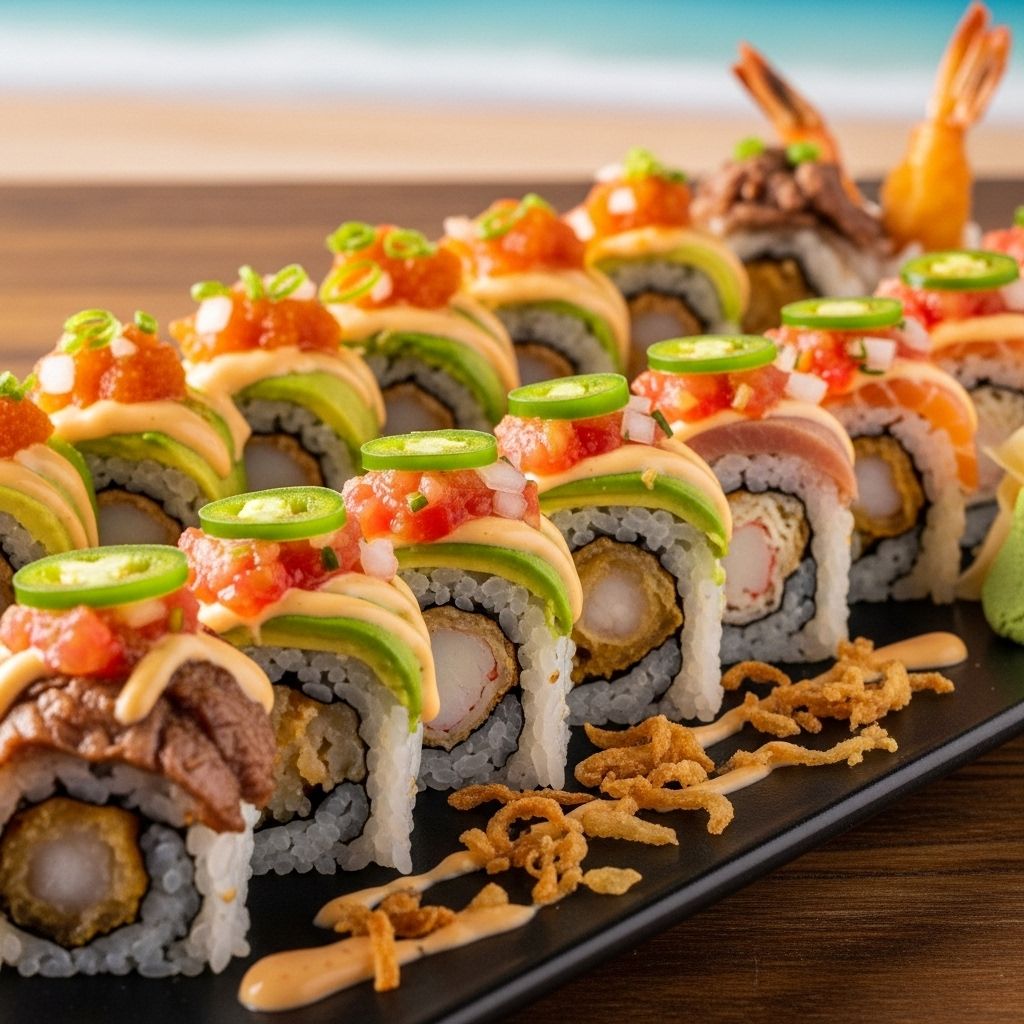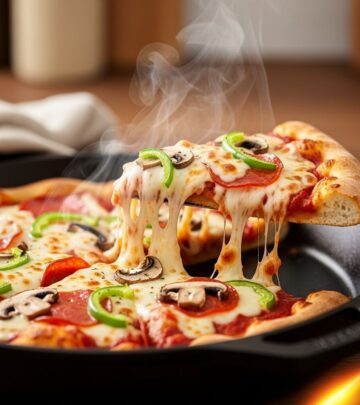The Vibrant History and Cultural Impact of Sinaloan Sushi
Sinaloa’s coastal flair meets sushi craft, creating a vibrant taste revolution.

The Birth and Bold Evolution of Sinaloan Sushi
Sinaloan sushi is more than just a culinary experiment; it is a vivid tale of cultural fusion, creativity, and regional pride. Born on the northern coast of Mexico and now found in cities from Los Angeles to Toronto, Sinaloan sushi stands as a testament to the innovative spirit that flourishes where tradition meets invention. This article traces the journey of Sinaloan sushi from its origins in Culiacán to its dynamic spread and growing international acclaim, highlighting the story behind its unique blend of Mexican and Japanese flavors.
How Sinaloan Sushi Was Born
The idea of sushi in Mexico may seem unexpected, but its origins are deeply rooted in the state’s rich seafood tradition and cross-cultural openness. Sinaloa, lining Mexico’s Pacific coast, is renowned for its ceviches and aguachiles. To understand how sushi arrived in Sinaloa, one must consider the local penchant for seafood and the willingness to reinterpret international cuisines with a distinctly regional twist.
According to chef Ronald Guerrero, who now helms Culichi Town near Los Angeles, the invention of Mexican sushi was spontaneous—a sushi chef in Sinaloa decided to innovate, wrapping sticky rice around grilled skirt steak, a local favorite. This wasn’t an attempt to mimic classic Japanese sushi, but rather to make something new and unapologetically Mexican. From the sizzle of carne asada to the crunch of jalapeño and the creamy notes of queso filadelfia (cream cheese), this culinary hybrid was destined for local popularity—and eventually, wider fame.
Culiacán: The Cradle of Sinaloan Sushi
- Culiacán, the capital of Sinaloa, is widely considered the birthplace of Sinaloan sushi, with early versions appearing in the early 2000s.
- Coastal Sinaloa’s seafood abundance inspired even more creativity, as chefs integrated local flavors and ingredients.
- From its initial popularity in Sinaloa, the phenomenon quickly attracted attention throughout northern Mexico, with sushi restaurants springing up in Hermosillo (Sonora) and nearby cities.
The Art and Ingredients of Fusion
Sinaloan sushi is the product of centuries of global influence on Mexican cuisine. The dish combines foundational components of Japanese sushi—sticky rice, seaweed, and fish—with Mexican essential flavors such as chilies, grilled meats, and even sauces popular in street food.
Key Components That Make Sinaloan Sushi Unique
- Sinaloa Spices: Instead of wasabi, Sinaloan sushi delivers heat through local chilies like chipotle, chiltepin, and jalapeño.
- Creative Fillings: You’ll find grilled carne asada, cooked shrimp, mozzarella cheese, chipotle cream, bacon, cilantro, and sometimes even American cheese—melding Japanese technique with Mexican and American comfort foods.
- Deep-Frying: Many Sinaloan rolls are battered and fried for extra crunch, far departing from traditional Japanese raw fish sushi.
- Toppings and Sauces: Rolls might be topped with spicy chipotle or buffalo sauces, shredded meats, and creamy dressings.
- Wraps: Some Sinaloan sushi versions use mango or plantain slices as wraps, creating a vibrant sweet-savory contrast.
- Queso Filadelfia: Cream cheese is celebrated in Sinaloan sushi, a nod to both local and imported tastes.
Table: Japanese Sushi vs. Sinaloan Sushi
| Feature | Japanese Sushi | Sinaloan Sushi |
|---|---|---|
| Main Ingredients | Raw fish, sticky rice, nori, wasabi | Cooked meats, cheese, chipotle, chilies, sticky rice, nori |
| Heat/Spice | Wasabi, pickled ginger | Jalapeño, chipotle, chiltepin |
| Toppings | Fish, roe, cucumber, avocado | Bacon, mozzarella, buffalo chicken, chipotle sauce |
| Preparation Styles | Raw, lightly seared | Cooked, deep-fried, grilled |
| Wraps | Nori seaweed sheets | Mango, plantain, nori |
Spreading the Sinaloan Sushi Revolution
The popularity of Sinaloan sushi in Culiacán soon sparked a culinary wave across Mexico and into the United States—and beyond.
- Early Adoption: Sinaloan sushi appeared in Los Angeles County restaurants around 2013, followed by the first Mexican sushi restaurant in Orange County in 2015.
- Regional Growth: By 2016, at least six Mexican sushi spots had opened in Phoenix, Arizona. The movement continued, with restaurants popping up in Houston, Denver, Kent, Washington, and Tacoma, Washington between 2017 and 2021.
- International Leap: By 2022, Sinaloan sushi had crossed the border into Canada, appearing in Toronto.
As Mexican diaspora communities expanded in the U.S., so did their appetite for hometown flavors. Families in Los Angeles, Tucson, and Phoenix now gather at Mexican-style sushi restaurants just as they would back home in Hermosillo or Culiacán.
Mexican Cuisine: A Tradition of Global Fusion
Sinaloan sushi isn’t an isolated phenomenon, but rather the latest chapter in Mexico’s centuries-old history of culinary fusion. Mexican cuisine blends Mesoamerican, Spanish, Middle Eastern, and Asian elements—a legacy fueled by trade, colonization, and waves of immigration.
Global Contributions to Mexican Food
- Indigenous Foundations: Staples like maize, beans, squash, and chilies have defined Mexican diets for millennia.
- Spanish Influence: The Spanish introduced livestock, citrus, rice, and new techniques, revolutionizing Mexican cooking with dishes like mole poblano.
- Middle Eastern Touch: Lebanese migrants brought the vertical spit, transforming Mexican pork into tacos al pastor—another fusion food icon.
- Asian Impact: The Manila-Acapulco Galleon trade brought Asian ingredients such as soy sauce and rice to Mexican shores, influencing coastal cooking and dishes like Sinaloan sushi and Mexican-Chinese stir-fries.
Modern chefs across Mexico—and abroad—continue this tradition, adapting global techniques and ingredients to create bold, regionally distinctive flavors.
Northern Mexico: Hub of Innovation
Northern Mexican cities, especially Sinaloa, Sonora, and Baja California, are acclaimed for their creative takes on international trends. Culinary innovation flourishes in borderland regions, where culture and cuisine intermix freely.
- Sonoran-Style Hotdogs: American hotdogs wrapped in bacon, topped with pico de gallo, jalapeños, and beans, originated in Hermosillo—a parallel story to Sinaloan sushi.
- Caesar Salad: Created in Tijuana by an Italian-American chef, it blended European and Mexican flavors.
- Baja Med Cuisine: Chefs in cities like Ensenada and Tijuana combine Mediterranean techniques with Mexican seafood, further exemplifying this creative culinary spirit.
The invention of Sinaloan sushi continues this borderland tradition of adapting world flavors into local favorites, blending homegrown ingredients with international concepts to create dishes that are at once familiar and refreshingly new.
The Contemporary Sinaloan Sushi Experience
Diners today expect Sinaloan sushi to deliver a unique amalgamation of flavors, textures, and presentation styles. Popular Mexican sushi chains like Culichi Town have standardized certain elements, making them the go-to spots for spicy, creamy, and innovative sushi rolls.
Signature Dishes and Trends
- Deep-Fried Rolls: Crispy, golden exteriors cradling tender meats and gooey cheese.
- Buffalo Chicken Topped Rolls: In places like South Tucson, some Sinaloan sushi rolls are crowned with boneless wings, adding American bar-food flair.
- Fruit-Wrapped Rolls: Mango or plantain wraps are especially popular in Mexico City, introducing a tropical sweetness to the dish.
- Bold Sauces: Chipotle, cilantro cream, and spicy Sinaloan blends replace wasabi and soy sauce as primary condiments.
Menus across Mexican sushi eateries are often playful, featuring rolls named after local neighborhoods, pop culture references, or family favorites. The experience is less formal than traditional Japanese sushi bars—meant for sharing, celebration, and fun.
Cultural Impact: More Than Food
Sinaloan sushi is not merely a dish; it’s a cultural statement. As families and friends gather over crunchy, spicy rolls, they are partaking in a story of cross-border movement and adaptation.
- Symbol of Regional Identity: Sinaloan sushi is a point of pride for the people of Sinaloa and Mexican communities in the U.S., highlighting local creativity in the face of stereotype and tradition.
- Celebration of Fusion: This dish exemplifies Mexico’s openness to global influence while fiercely defending its own flavor identity.
- Spread of Mexican Foodways: The proliferation of Sinaloan sushi in U.S. cities and abroad illustrates how migration and cultural interchange fuel new culinary trends.
The Future of Sinaloan Sushi
With new restaurants opening regularly in both Mexico and the United States, Sinaloan sushi is evolving rapidly. Chefs continue to innovate, incorporating influences from American fast food to Asian sauces and vegetables, and catering to diverse multicultural communities.
- Global Expansion: Sinaloan sushi’s arrival in Canadian cities like Toronto signals its potential to become a global staple of fusion cuisine.
- Menu Evolution: New variations feature vegetarian rolls, unique sauces, novel fillings, and presentations—proof of ongoing creativity.
- Media and Pop Culture: Social media and food blogs have helped broadcast Sinaloan sushi’s appeal, enticing adventurous eaters worldwide.
It remains to be seen how Sinaloan sushi will evolve next—but one thing is certain: its spirit of fusion, boldness, and joy will continue to inspire new generations of chefs and food lovers.
Frequently Asked Questions (FAQs)
Q: What is Sinaloan sushi?
A: Sinaloan sushi is a Mexican-Japanese fusion dish originating in Sinaloa, Mexico. It features sushi rolls filled with cooked meats, cheese, and spicy Mexican condiments, often deviating from traditional Japanese sushi by being fried, topped with sauces, or wrapped with non-traditional ingredients.
Q: Where did Sinaloan sushi originate?
A: It is widely accepted that Sinaloan sushi originated in Culiacán, the capital of Sinaloa, in the early 2000s, where local chefs creatively adapted sushi to Mexican tastes.
Q: How does Sinaloan sushi differ from Japanese sushi?
A: While both use sticky rice and seaweed, Sinaloan sushi features cooked meats (such as carne asada or bacon), cheese, chipotle and jalapeño peppers, and is often deep-fried or sauced, rather than emphasizing raw fish and subtle flavors.
Q: Where can I find Sinaloan sushi?
A: Sinaloan sushi restaurants can be found in major Mexican and American cities, particularly in Los Angeles, Phoenix, Houston, and Toronto, as well as in Sinaloa and Sonora, Mexico.
Q: Is Sinaloan sushi considered authentic Mexican food?
A: Sinaloan sushi is authentic to northern Mexico’s fusion food tradition, representing local interpretation rather than traditional Mexican or Japanese cuisine. It embodies the creativity and adaptability found in Mexican cooking.
Related Topics and Further Reading
- Sushi burrito—another North American twist blending sushi techniques with local fillings
- Baja Med Cuisine—Mediterranean-Mexican fusion popular in northern Baja California
- Sonoran-style Hotdogs—an example of American-Mexican street food innovation
References
Read full bio of medha deb












